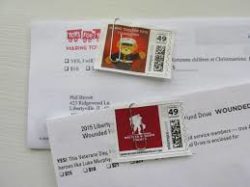Stamps: Buy Forever by Jan 22; consider trying custom stamps; relief may be on the way for low denominations
Postage stamps are important tools for many nonprofits. People tend to assume that stamps are only used by the ever-diminishing personal letter writer and bill payer. But nonprofits use First Class stamps on outbound letters and on response letters, finding that they get better results.
The price of First Class Forever stamps will go up by 4.3 Percent on January 22, 2017, from 47 to 49 cents. So, if you plan to use Forever stamps, buy as many as your budget allows before January 22! They are good for the prevailing First Class rate as long as the USPS is delivering, which will be a long time. Business Reply Mail will also go up, but there is no Forever version.
An alternative to USPS First Class stamps is customized postage issued by approved licensed vendors such as Stamps.com. Some nonprofits have been testing the use of such custom stamps with their choice of image such as their logo. Now there will be a huge price incentive to do so. Starting January 22, the USPS will lower the price of metered postage, that includes custom stamps, to 46 cents from 46.5 cents. This will increase the price discount for metered and custom stamps issued by vendors to 3 cents from ½ cent.
Why did the USPS create such an incentive to use postage provided by vendors rather than its own stamps? The answer lies in the postal management decision to raise the stamp price back to where it was under the exigent surcharge. As First Class is subject to a CPI price cap of about 0.9 percent, if you raise a major category by 4.3 percent, you need to lower most of the other sub-classes in First Class. In addition to metered postage, First Class presorted letters and cards postage rates were lowered an average o.25 percent.
If you have been thinking about trying custom stamps to increase your response rates, 2017 is the year to do it. At meetings, postal officials have warned that the 3 cents per piece bonanza to be enjoyed by users of metered and custom postage will not last forever. It clearly was a subordinate adjustment to the higher-level decision to bring stamps back to 49 cents.
Another thing some nonprofit mailers successfully do with stamps is to place several low-denomination stamps that add up to the First Class rate on response envelopes. Some large nonprofits have found this a very successful strategy.
The recent problem has been that the USPS has not been offering the right combination of stamps in large rolls to add up to 47 cents, or 49 cents. Even if they add up, they can cover up the response address because of the number of stamps you need to use.
The USPS has agreed to look at this issue for us. First Class Mail letters are already quite profitable, and when a high percentage of stamps are not actually used, it would seem to make sense for USPS to work with nonprofit customers to ensure the availability of sufficient, workable low denomination stamps.
We recently sent a request to our members asking for their data on the use of low denomination stamps that can be shared with USPS so a business decision can be made. We also have suggested that USPS create rolls of low denomination stamps that are printed together in rows that add up to the First Class rate and can be applied with automation. But availability of the right combination of stamps on large rolls that add up to First Class would be a big step in the right direction.



Leave a Reply